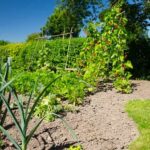Do moles damage vegetable gardens? These elusive creatures often spark curiosity and concern among gardeners. From their distinctive tunnels to the potential impact on plant health, understanding the role of moles in gardens is essential for maintaining a thriving vegetable patch.
In this blog post, we will explore the behavior of moles in vegetable gardens, signs of mole damage, the impact on vegetable plants, prevention and control methods, natural predators of moles, as well as the benefits of mole activity in garden soil. By shedding light on these topics, readers will gain valuable insights into managing mole activity in their own vegetable gardens.
Moles are fascinating creatures that play a significant role in garden ecosystems. Their distinctive tunnel systems and foraging behavior can have both positive and negative impacts on vegetable gardens. Understanding the behavior and habits of moles is crucial for effectively managing their presence and minimizing potential damage to valuable crops. By delving into this topic, readers can gain a deeper understanding of how moles interact with vegetable plants and garden soil.
Identifying signs of mole damage is essential for taking prompt action to minimize its impact on vegetable plants. From visible tunnel networks to upturned soil and wilting plants, recognizing the indicators of mole activity can empower gardeners to protect their crops from further harm. By learning how to identify mole damage, readers can take proactive measures to address any issues that may arise in their own vegetable gardens.
The Role of Moles in Gardens
Moles are a common sight in many gardens, and their presence can have both positive and negative effects on vegetable plants. Understanding the role of moles in gardens is essential for gardeners looking to protect their crops from potential damage.
Behavior and Habits
Moles are burrowing mammals that spend most of their lives underground. They are often attracted to gardens because of the rich soil and abundance of earthworms, grubs, and other insects – all of which make for a veritable feast for these animals. Moles create elaborate tunnel systems as they search for food, which can result in extensive digging and tunneling throughout the garden.
Potential Impact on Plant Health
While moles do not directly feed on vegetable plants, their burrowing activities can have indirect effects on plant health. As moles tunnel through the soil, they can disturb plant roots, causing them to become dislodged or damaged. This disturbance can lead to nutrient deficiencies in plants and hinder their ability to take up water, ultimately impacting crop yield and quality.
Gardeners may notice raised ridges or mounds of dirt in their garden beds, which are telltale signs of mole activity. These signs can serve as an indication that further investigation is needed to assess the extent of potential damage caused by moles. By understanding the behavior and habits of moles in gardens, it becomes possible for gardeners to take proactive measures to protect their vegetable plants from potential harm.
Signs of Mole Damage
Identifying Mole Damage
The presence of moles in a vegetable garden can often be identified by the appearance of raised, winding ridges or tunnels in the soil. These are known as mole runs, and they are created as moles burrow through the ground in search of food.
Additionally, small mounds of soil may appear on the surface of the garden, which are indicative of mole activity below. Another sign of mole damage is the wilting or yellowing of plants, as moles can disrupt root systems and hinder nutrient uptake.
Visual Examples
To better understand what mole damage looks like in a vegetable garden, it can be helpful to reference visual examples. Images showing raised tunnels in the soil, as well as plants with damaged roots or foliage, can give gardeners a clear idea of what to look for when assessing their own gardens for signs of mole activity.
Impact on Soil Structure
In addition to visible signs above ground, moles can also cause damage to the soil structure. Their burrowing activities can loosen and aerate the soil, potentially leading to improved drainage and root development for some plants. However, excessive mole activity can also disrupt the root systems of vegetables and lead to decreased plant health and productivity.
It’s important for gardeners to familiarize themselves with these signs so they
Impact on Vegetable Plants
Moles can significantly impact vegetable plants in a garden, leading to potential consequences for crop yield and quality. Here are some specific ways moles can damage vegetable plants:
1. Root Damage: Moles tunnel underground in search of insects, grubs, and earthworms, often causing root damage to vegetable plants as they create their pathways. This can hinder the plant’s ability to absorb nutrients and water from the soil, leading to stunted growth and reduced productivity.
2. Soil Aeration: While moles’ tunneling activities can aerate the soil, excessive tunneling can disrupt the root systems of vegetable plants and cause them to become dislodged from the ground. This can lead to wilting and withering of the affected plants.
3. Exposure to Pests: Mole tunnels can serve as entry points for other pests such as voles and mice, which might feed on or disturb vegetable crops. In some cases, moles themselves may accidentally damage plants while excavating their tunnels, potentially uprooting or disturbing young seedlings.
It is important for gardeners to be aware of these potential impacts and take proactive measures to prevent or mitigate mole damage in their vegetable gardens. By understanding the specific ways moles can affect vegetable plants, gardeners can better protect their crops and ensure a bountiful harvest.
Overall, it is crucial for gardeners to closely monitor their vegetable gardens for signs of mole activity and take appropriate steps to address any potential damage caused by these underground dwellers. By implementing effective prevention and control methods, it is possible to minimize the negative impact of moles on vegetable plants and maintain a healthy garden environment.
Prevention and Control Methods
When it comes to moles and their potential damage to vegetable gardens, it’s important for gardeners to be proactive in implementing prevention and control methods. While moles play a vital role in soil health, their tunneling habits can lead to significant damage to plant roots and crops. So, what can gardeners do to minimize the impact of moles on their vegetable gardens?
One effective method for preventing mole damage is to install barriers such as underground fencing made of wire mesh or hardware cloth. These barriers should be buried at least 24 inches deep to deter moles from tunneling into the garden beds. Additionally, creating raised beds with bottom liners made of wire mesh can also help prevent mole intrusion.
Another approach to controlling mole populations in vegetable gardens is to use natural repellents such as castor oil-based products. These repellents create an unpleasant environment for moles, encouraging them to seek food sources elsewhere without causing harm. Additionally, introducing natural predators of moles, such as domesticated cats or certain species of snakes, can help keep mole populations in check.
Gardeners can also explore environmentally friendly methods for controlling mole activity, such as promoting the presence of earthworms and beneficial insects that serve as natural competitors to moles. By maintaining healthy soil ecology and biodiversity in the garden, gardeners can create an environment that naturally regulates mole populations while supporting plant growth.
| Prevention Method | Effectiveness |
|---|---|
| Installing underground barriers | Highly effective in preventing mole intrusion |
| Using natural repellents | Provides a non-harmful deterrent for moles |
| Attracting natural predators | Contributes to keeping mole populations in check |
Natural Predators of Moles
Moles are known for their underground tunneling and foraging behavior, which can lead to potential damage in vegetable gardens. While they play a role in aerating the soil and controlling insect populations, their activity can also have negative effects on the health and yield of vegetable plants. Understanding the natural predators of moles can provide insight into how to manage mole populations in garden settings.
Natural predators of moles play a crucial role in keeping mole populations in check. By attracting and encouraging these predators to frequent the garden area, it is possible to mitigate the impact of moles on vegetable plants. Some common natural predators of moles include:
- Owls: These nocturnal birds of prey are efficient hunters and feed on a variety of small mammals, including moles.
- Snakes: Certain snake species, such as garter snakes and eastern hognose snakes, are known to consume moles as part of their diet.
- Domestic cats: Cats are natural hunters and may help control mole populations in garden areas.
By creating an environment that supports these natural predators, gardeners can help maintain a balance between mole activity and plant health. This approach emphasizes ecological solutions over harmful chemical controls, promoting a harmonious relationship between wildlife and gardening efforts.
In addition to attracting natural predators, implementing proactive measures such as maintaining a diverse habitat with suitable shelter and food sources for predator species can contribute to effective mole population management in vegetable gardens. By understanding the role of natural predators in controlling mole populations, gardeners can work towards finding sustainable solutions for protecting their crops from potential damage caused by moles.
Benefits of Mole Activity
The presence of moles in vegetable gardens can often raise concerns about the potential damage they may cause to plants and soil. However, it’s important to recognize that moles also play a beneficial role in garden ecosystems. Understanding the positive aspects of mole activity can provide a more balanced perspective on their presence in vegetable gardens.
One significant benefit of mole activity is their role in aerating and improving soil quality. As moles tunnel through the earth in search of insects and grubs, they inadvertently loosen and mix the soil, creating channels for air and water to penetrate the ground. This natural tilling action helps to improve soil structure, drainage, and nutrient distribution, which ultimately benefits the health and growth of vegetable plants.
In addition to improving soil quality, moles also contribute to pest control in garden environments. Their primary diet consists of insects, larvae, and small pests that can be detrimental to vegetable crops. By consuming these pests, moles help to keep insect populations in check, reducing the likelihood of pest-related damage to garden plants. This natural form of pest control can be especially valuable for organic gardeners who prefer environmentally friendly methods of managing insect infestations.
| Benefit | Description |
|---|---|
| Soil Aeration | Moles tunneling activity improves soil structure by loosening and mixing the soil, promoting better drainage and nutrient distribution. |
| Pest Control | Moles consume insects and pests that can be harmful to vegetable plants, helping to naturally manage pest populations in the garden. |
Conclusion
In conclusion, it is evident that moles can indeed cause damage to vegetable gardens. Their burrowing and tunneling behavior can disrupt plant roots, leading to stunted growth and decreased crop yields.
Identifying signs of mole damage such as raised ridges and uprooted plants is crucial for implementing effective prevention and control methods. While it’s important to protect vegetable gardens from mole damage, it’s also essential to consider the potential benefits of mole activity in garden soil and their role in the ecosystem.
By following the practical tips and strategies for preventing mole damage outlined in this article, gardeners can take proactive steps to safeguard their vegetable plants. From installing physical barriers to encouraging natural predators like snakes and birds, there are various environmentally friendly ways to control mole populations without resorting to harmful chemicals or traps.
In taking proactive measures to prevent mole damage in vegetable gardens, gardeners can ensure the health and productivity of their crops while maintaining a balanced ecosystem. By understanding the behavior of moles and their impact on plant health, gardeners can make informed decisions about promoting a harmonious coexistence with these underground inhabitants.
Frequently Asked Questions
Will a Mole Ruin My Vegetable Garden?
Moles can have a negative impact on a vegetable garden by creating tunnels and mounds that can disrupt the root systems of plants. However, they typically do not eat vegetable plants themselves, so their primary effect is on the garden’s structure.
How Do You Get Rid of Moles in Your Vegetable Garden?
There are multiple methods for getting rid of moles in a vegetable garden, including using traps, repellents, and barriers such as underground fencing or mesh. Another tactic is to reduce the mole’s food source by controlling insects and grubs in the garden.
What Vegetables Will Moles Not Eat?
Moles generally prefer to eat insects, grubs, and earthworms rather than vegetable plants. As a result, they tend to avoid consuming most types of vegetables. However, it’s essential to note that while moles may not eat vegetables directly, their tunneling activity can still damage roots and disrupt plant growth.

If you’re looking to get into vegetable gardening, or are just looking for some tips on how to make your current garden better, then you’ve come to the right place! My name is Ethel and I have been gardening for years. In this blog, I’m going to share with you some of my best tips on how to create a successful vegetable garden.





